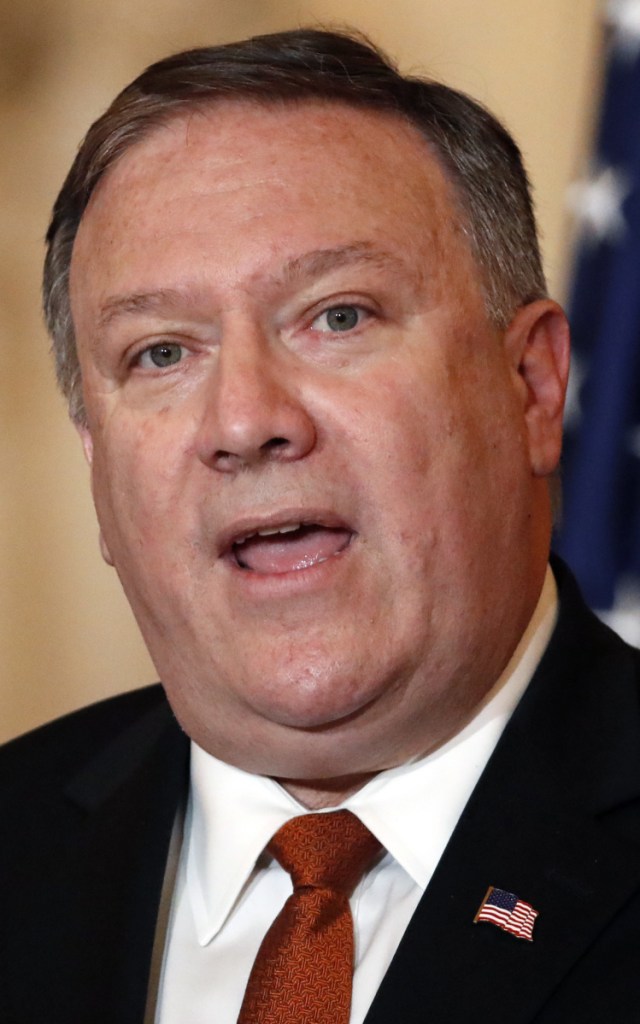YOKOTA AIR BASE, Japan — Secretary of State Mike Pompeo traveled to North Korea on Tuesday to nail down critical details for an upcoming summit between President Trump and North Korean leader Kim Jong Un, raising hopes that three American prisoners could soon be released.
But even as Pompeo landed in Japan for a refueling stop, he acknowledged that there was little certainty about the outcome of his visit, saying he was not sure with whom he would be meeting or whether the Americans would be freed.
Trump first disclosed the trip during remarks at the White House on his intention to withdraw the United States from the Iran nuclear deal. The president cast Pompeo’s second visit as a step forward in the preparation for the summit, which could happen by late June.
“Plans are being made. Relationships are building,” Trump said of the diplomatic opening with the Kim regime. “Hopefully, a deal will happen and, with the help of China, South Korea, and Japan, a future of great prosperity and security can be achieved for everyone.”
Yet important details remain unresolved, including when and where the leaders’ meeting will take place. Trump has suggested it could happen in Singapore or in the demilitarized zone between North Korea and South Korea.
During his remarks, Trump made no mention of the American prisoners, after suggesting last week that their release was imminent. Two people with knowledge of the trip had told The Washington Post before Trump’s speech that Pompeo was expected to bring the prisoners home.
“We’ll all soon be finding out,” Trump replied to a reporter’s question on their fate.
Three Korean Americans – Kim Dong-chul, Kim Hak-song and Tony Kim – have been accused of various acts considered hostile to the government. Trump and his lawyer, Rudy Giuliani, have dropped hints recently that they could be freed soon.
One of the prisoners, Kim Dong-chul, a former Virginia resident in his mid-60s, was detained in October 2015, while the other two were detained after Trump took office.
In an interview with two journalists traveling with him aboard his plane, including a Post reporter, Pompeo said he plans to raise again the U.S. desire that the three men be freed, adding, “It’d be a great gesture if they’d agree to do so.”
The main purpose of Pompeo’s visit to North Korea is to finalize a time and location for the summit between Trump and the North Korean leader, how long their talks will last and to clarify expectations.
“We also want to make sure what our expectations are not,” Pompeo said. “We are not going to head down the path we headed down before. We will not relieve sanctions until such time as we have achieved our objectives. We’re not going to do this in small increments, where the world is coerced into relieving economic pressures.”
Pompeo’s trip came just a day after Kim made a second visit in two months to China to meet with President Xi Jinping, this time in Dalian, where the two leaders were photographed strolling along a beach. The White House said Trump spoke with Xi after that meeting and that the U.S. and Chinese presidents agreed to maintain economic sanctions on North Korea “until it permanently dismantles its nuclear and missile programs.”
Pompeo left Washington from Joint Base Andrews late Monday on a trip that was not announced by the State Department. He was accompanied by several other senior officials, including Brian Hook, State’s policy planning chief, and Matthew Pottinger, the senior Asia director at the National Security Council.
Pompeo’s return to North Korea comes in his second week as the administration’s top diplomat. Arrangements were made in great secrecy befitting a former CIA director. Pompeo has promised to “bring back the swagger” to a State Department that has been sidelined in some foreign policy debates. His high-profile visit appears to be a splashy step in that direction.
Pompeo may get an earful from the officials he meets. Pyongyang has been disgruntled over what it called “misleading” assertions from some U.S. officials that North Korea is considering denuclearization because it fears U.S. military prowess and to alleviate punishing sanctions – a “maximum pressure campaign” laid out by Pompeo’s predecessor, Rex Tillerson, who was fired by Trump in March.
North Korea made its displeasure clear Sunday, the day before Pompeo departed Washington. A spokesman for its foreign ministry labeled the U.S. claims of credit for the apparent shift in North Korean policy a “dangerous attempt” to upset detente between two nations whose leaders only a few months ago were threatening nuclear war.
Send questions/comments to the editors.



Success. Please wait for the page to reload. If the page does not reload within 5 seconds, please refresh the page.
Enter your email and password to access comments.
Hi, to comment on stories you must . This profile is in addition to your subscription and website login.
Already have a commenting profile? .
Invalid username/password.
Please check your email to confirm and complete your registration.
Only subscribers are eligible to post comments. Please subscribe or login first for digital access. Here’s why.
Use the form below to reset your password. When you've submitted your account email, we will send an email with a reset code.